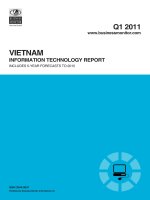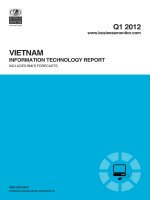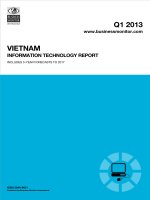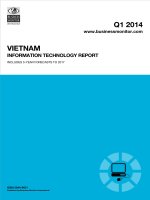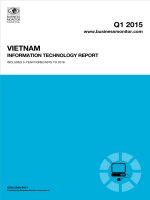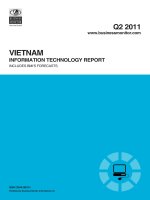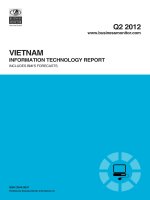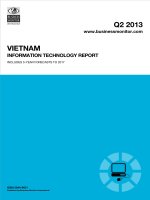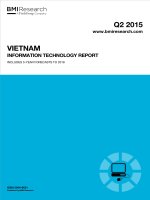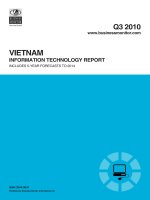Vietnam information technology report q1 2016
Bạn đang xem bản rút gọn của tài liệu. Xem và tải ngay bản đầy đủ của tài liệu tại đây (376.67 KB, 73 trang )
Q1 2016
www.bmiresearch.com
VIETNAM
INFORMATION TECHNOLOGY REPORT
INCLUDES 5-YEAR FORECASTS TO 2019
Published by:BMI Research
Vietnam Information Technology Report
Q1 2016
INCLUDES 5-YEAR FORECASTS TO 2019
Part of BMI’s Industry Report & Forecasts Series
Published by: BMI Research
Copy deadline: December 2015
ISSN: 2044-9631
BMI Research
Senator House
85 Queen Victoria Street
London
EC4V 4AB
United Kingdom
Tel: +44 (0) 20 7248 0468
Fax: +44 (0) 20 7248 0467
Email:
Web:
© 2016 Business Monitor International Ltd
All rights reserved.
All information contained in this publication is
copyrighted in the name of Business Monitor
International Ltd, and as such no part of this
publication may be reproduced, repackaged,
redistributed, resold in whole or in any part, or used
in any form or by any means graphic, electronic or
mechanical, including photocopying, recording,
taping, or by information storage or retrieval, or by
any other means, without the express written consent
of the publisher.
DISCLAIMER
All information contained in this publication has been researched and compiled from sources believed to be accurate and reliable at the time of
publishing. However, in view of the natural scope for human and/or mechanical error, either at source or during production, Business Monitor
International Ltd accepts no liability whatsoever for any loss or damage resulting from errors, inaccuracies or omissions affecting any part of the
publication. All information is provided without warranty, and Business Monitor International Ltd makes no representation of warranty of any kind
as to the accuracy or completeness of any information hereto contained.
Vietnam Information Technology Report
Q1 2016
INCLUDES 5-YEAR FORECASTS TO 2019
Part of BMI’s Industry Report & Forecasts Series
Published by: BMI Research
Copy deadline: December 2015
ISSN: 2044-9631
BMI Research
Senator House
85 Queen Victoria Street
London
EC4V 4AB
United Kingdom
Tel: +44 (0) 20 7248 0468
Fax: +44 (0) 20 7248 0467
Email:
Web:
© 2016 Business Monitor International Ltd
All rights reserved.
All information contained in this publication is
copyrighted in the name of Business Monitor
International Ltd, and as such no part of this
publication may be reproduced, repackaged,
redistributed, resold in whole or in any part, or used
in any form or by any means graphic, electronic or
mechanical, including photocopying, recording,
taping, or by information storage or retrieval, or by
any other means, without the express written consent
of the publisher.
DISCLAIMER
All information contained in this publication has been researched and compiled from sources believed to be accurate and reliable at the time of
publishing. However, in view of the natural scope for human and/or mechanical error, either at source or during production, Business Monitor
International Ltd accepts no liability whatsoever for any loss or damage resulting from errors, inaccuracies or omissions affecting any part of the
publication. All information is provided without warranty, and Business Monitor International Ltd makes no representation of warranty of any kind
as to the accuracy or completeness of any information hereto contained.
Vietnam Information Technology Report Q1 2016
CONTENTS
BMI Industry View ............................................................................................................... 7
SWOT .................................................................................................................................... 9
IT SWOT .................................................................................................................................................. 9
Industry Forecast .............................................................................................................. 11
Latest Updates ....................................................................................................................................... 11
Structural Trends ................................................................................................................................... 11
Table: IT Industry - Historical Data And Forecasts (Vietnam 2012-2019) . . . . . . . . . . . . . . . . . . . . . . . . . . . . . . . . . . . . . . . . . . . . . . . . . . . . . . . . . . . . . . . . . . . . . . . . . . . . 18
Industry Risk Reward Index ............................................................................................. 19
Table: Asia Pacific IT Risk/Reward Index - Q1 2016 . . . . . . . . . . . . . . . . . . . . . . . . . . . . . . . . . . . . . . . . . . . . . . . . . . . . . . . . . . . . . . . . . . . . . . . . . . . . . . . . . . . . . . . . . . . . . . . . . . 21
Market Overview ............................................................................................................... 22
Recent Developments ..............................................................................................................................
Hardware .............................................................................................................................................
Software ...............................................................................................................................................
Cloud Computing ...................................................................................................................................
Services ................................................................................................................................................
22
22
28
35
39
Industry Trends And Developments ................................................................................ 46
Regulatory Development .................................................................................................. 50
Table: Government Authority . . . . . . . . . . . . . . . . . . . . . . . . . . . . . . . . . . . . . . . . . . . . . . . . . . . . . . . . . . . . . . . . . . . . . . . . . . . . . . . . . . . . . . . . . . . . . . . . . . . . . . . . . . . . . . . . . . . . . . . . . . . 50
Regulatory News .................................................................................................................................... 53
Competitive Landscape .................................................................................................... 55
International Companies ......................................................................................................................... 55
Table: Global CyberSoft . . . . . . . . . . . . . . . . . . . . . . . . . . . . . . . . . . . . . . . . . . . . . . . . . . . . . . . . . . . . . . . . . . . . . . . . . . . . . . . . . . . . . . . . . . . . . . . . . . . . . . . . . . . . . . . . . . . . . . . . . . . . . . . . 55
Table: Intel . . . . . . . . . . . . . . . . . . . . . . . . . . . . . . . . . . . . . . . . . . . . . . . . . . . . . . . . . . . . . . . . . . . . . . . . . . . . . . . . . . . . . . . . . . . . . . . . . . . . . . . . . . . . . . . . . . . . . . . . . . . . . . . . . . . . . . . . . . . . . . 56
Table: LG Electronics . . . . . . . . . . . . . . . . . . . . . . . . . . . . . . . . . . . . . . . . . . . . . . . . . . . . . . . . . . . . . . . . . . . . . . . . . . . . . . . . . . . . . . . . . . . . . . . . . . . . . . . . . . . . . . . . . . . . . . . . . . . . . . . . . . 57
Table: Samsung Electronics . . . . . . . . . . . . . . . . . . . . . . . . . . . . . . . . . . . . . . . . . . . . . . . . . . . . . . . . . . . . . . . . . . . . . . . . . . . . . . . . . . . . . . . . . . . . . . . . . . . . . . . . . . . . . . . . . . . . . . . . . . . . 58
Local Companies ................................................................................................................................... 59
Table: Sara Vietnam . . . . . . . . . . . . . . . . . . . . . . . . . . . . . . . . . . . . . . . . . . . . . . . . . . . . . . . . . . . . . . . . . . . . . . . . . . . . . . . . . . . . . . . . . . . . . . . . . . . . . . . . . . . . . . . . . . . . . . . . . . . . . . . . . . . . 59
Regional Overview ............................................................................................................ 60
Asia - Local Vendors Leverage Emerging Lower-End Device Market ................................................................ 60
Demographic Forecast ..................................................................................................... 63
Table: Population Headline Indicators (Vietnam 1990-2025) . . . . . . . . . . . . . . . . . . . . . . . . . . . . . . . . . . . . . . . . . . . . . . . . . . . . . . . . . . . . . . . . . . . . . . . . . . . . . . . . . . . . . . . . . 64
Table: Key Population Ratios (Vietnam 1990-2025) . . . . . . . . . . . . . . . . . . . . . . . . . . . . . . . . . . . . . . . . . . . . . . . . . . . . . . . . . . . . . . . . . . . . . . . . . . . . . . . . . . . . . . . . . . . . . . . . . . . 64
Table: Urban/Rural Population & Life Expectancy (Vietnam 1990-2025) . . . . . . . . . . . . . . . . . . . . . . . . . . . . . . . . . . . . . . . . . . . . . . . . . . . . . . . . . . . . . . . . . . . . . . . . . . . . 65
Table: Population By Age Group (Vietnam 1990-2025) . . . . . . . . . . . . . . . . . . . . . . . . . . . . . . . . . . . . . . . . . . . . . . . . . . . . . . . . . . . . . . . . . . . . . . . . . . . . . . . . . . . . . . . . . . . . . . . 65
Table: Population By Age Group % (Vietnam 1990-2025) . . . . . . . . . . . . . . . . . . . . . . . . . . . . . . . . . . . . . . . . . . . . . . . . . . . . . . . . . . . . . . . . . . . . . . . . . . . . . . . . . . . . . . . . . . . . 66
© Business Monitor International Ltd
Page 4
Vietnam Information Technology Report Q1 2016
Methodology ...................................................................................................................... 68
Industry Forecast Methodology ................................................................................................................ 68
Sources ................................................................................................................................................ 70
Risk/Reward Index Methodology ............................................................................................................... 70
Table: IT Risk/Reward Index Indicators . . . . . . . . . . . . . . . . . . . . . . . . . . . . . . . . . . . . . . . . . . . . . . . . . . . . . . . . . . . . . . . . . . . . . . . . . . . . . . . . . . . . . . . . . . . . . . . . . . . . . . . . . . . . . . . . 71
Table: Weighting Of Components . . . . . . . . . . . . . . . . . . . . . . . . . . . . . . . . . . . . . . . . . . . . . . . . . . . . . . . . . . . . . . . . . . . . . . . . . . . . . . . . . . . . . . . . . . . . . . . . . . . . . . . . . . . . . . . . . . . . . . 72
© Business Monitor International Ltd
Page 5
Vietnam Information Technology Report Q1 2016
BMI Industry View
BMI View: We believe Vietnam's IT market will be a regional outperformer over 2016-2019 due to strong
growth dynamics for retail and enterprise market demand. Broad-based economic growth is expected to
have a positive impact on the household income profile of Vietnam over the medium term, which will
deepen the retail hardware market, as well as easing price sensitivity in the higher-value replacement
market. Meanwhile, Vietnam's broader economic development including the expansion of higher
productivity verticals, and the modernisation of traditional sectors, will unlock demand for IT software and
services solutions. There is also increasing momentum towards Vietnam becoming a global centre for
electronics production as wages rise in China and manufacturers look to protect margins by moving to
Vietnam, where wages are as low as a third of those in China. We forecast a CAGR for the market of 13.5%
over 2016-2019, with total spending expected to increase to VND99.1trn in 2019.
Latest Updates And Industry Developments
■
Computer Hardware Sales: VND42.7trn in 2016 to VND55.6trn in 2019, a compound annual growth
rate (CAGR) of +10.7% in local currency terms. Significant growth potential exists due to low device
penetration rates, which we expect to be unlocked due to the strength of potential income growth trends
in Vietnam over 2016-2019.
■
Software Sales: VND10.9trn in 2016 to VND16.0trn in 2019, a CAGR of +15.7% in local currency
terms. Low enterprise software penetration is a major opportunity as firms modernise and become
integrated into global supply chains, with lower cost cloud software also expected to deepen the market.
■
IT Services Sales: VND17.2trn in 2016 to VND27.4trn in 2019, a CAGR of +18.9% in local currency
terms. IT services are forecast to outperform over 2016-2019 due to increased domestic demand for cloud
computing and outsourcing services from the private and public sectors.
© Business Monitor International Ltd
Page 7
Vietnam Information Technology Report Q1 2016
Rising Incomes And Enteprise Modernisation Support Bright Outlook For IT
Market
IT Market Growth Rate By Segment
25
20
15
10
5
2013
2014
2015e
2016f
2017f
2018f
2019f
Vietnam - Computer hardware sales, VNDmn, % y-o-y
Vietnam - Software sales, VNDmn, % y-o-y
Vietnam - Services sales, VNDmn, % y-o-y
f = BMI forecast. Source: BMI
© Business Monitor International Ltd
Page 8
Vietnam Information Technology Report Q1 2016
SWOT
IT SWOT
SWOT Analysis
Strengths
■
Supportive policy framework and funding in place to promote the development of the
IT sector.
■
Vietnam's gradual integration into the global trade network via its accession into trade
organisations such as the Association of Southeast Asian Nations and WTO, as well
as bilateral agreements with Japan and China.
■
The domestic IT market is in a rapid growth phase, with trade liberalisation and
growing affordability driving increased adoption among enterprises and consumers.
■
Expanding local hardware production industry with major international players such
as Samsung, Nokia, LG and Intel making large investments.
■
Vietnam is a preeminent global outsourcing destination, with a particular strength in
the software development industry.
Weaknesses
■
IT spend per capita is much lower than in neighbouring Thailand, reflecting a much
lower GDP per capita.
■
Highly price-sensitive market, putting pressure on vendor margins.
■
High level of software piracy, with a stall in the reduction 2011 to 2013.
■
Cybersecurity measures by the government have been pushed through with state
security measures, with potential human rights implications.
Opportunities
■
Broad-based economic growth forecast to drive retail hardware market growth as
household incomes increase markedly 2016-2019.
■
Decision in July 2014 to enable state agencies to use outsourced information
technology providers for the first time opens a new growth channel for vendors.
© Business Monitor International Ltd
Page 9
Vietnam Information Technology Report Q1 2016
SWOT Analysis - Continued
■
E-government adoption deepening, with opportunities in government administration,
alongside sector-specific markets such as healthcare.
■
Low PC penetration means there is scope for vendors to tap first-time buyer market
as well as the upgrade/replacement market. Due to low penetration desktop and
notebook sales continue to increase despite competition from tablets.
■
Low-cost tablets are proving popular with consumers, with significant medium-term
sales growth potential as incomes continue to rise.
■
Vietnam is a popular destination for software development and IT services
outsourcing, with particularly strong growth potential from Japanese enterprises that
are turning away from Chinese based providers.
■
Small- and medium-sized enterprises have much potential to increase spending on
basic solutions, including customer relationship management and security.
■
The government's drive to create an IT services industry over the next 15-20 years including the National Technology Innovation Fund - is expected to accelerate the
development of local enterprises.
■
Cloud computing awareness has risen fast and adoption is expected to accelerate in
the short-to-medium term as network infrastructure improves and awareness levels
increase.
Threats
■
Low-cost tablets from own-brand Chinese vendors a particular threat to low- and
mid-range notebook vendors. Falling prices may further undermine margins and
profitability after steep discounting.
■
Cybersecurity issues could undermine confidence in IT solutions and services, with
big data and cloud computing vulnerable.
■
Yen depreciation has hit the software outsourcing market by making exports less
competitive and eroding Vietnam's cost advantages.
© Business Monitor International Ltd
Page 10
Vietnam Information Technology Report Q1 2016
Industry Forecast
BMI View: We have a bullish outlook for IT market spending growth in Vietnam 2016-2019 based on
positive economic fundamentals that should result in broad-based income growth and enterprise investment
in modernisation. We maintain our long-held view that the Vietnamese IT market holds the potential for
medium-term outperformance, with a supportive government policy environment, declining device prices at
the global and regional level, the shift towards higher productivity activities such as manufacturing and
outsourcing, Vietnam's large and growing population, and finally investments in telecoms and retail
infrastructure all supplementing the economic outlook. BMI forecasts the Vietnamese IT market expanding
at a compound annual growth rate (CAGR) of 13.5% over 2016-2019, and the market is expected to reach a
value of almost VND99.07trn in 2019.
Latest Updates
■
IT market growth outlook for 2016-2019 upgraded slightly to reflect strong momentum across all three IT
market segments.
■
While Vietnam remains a low-income market in APAC, we identify broad-based economic growth trends
as a major positive factor for increases in IT hardware spending over the medium term.
■
Vietnam also stands to benefit from its emergence as an important hardware production location, as well
as the strong growth of its outsourcing industry, most importantly the gains made in the global software
development industry.
Structural Trends
2016 Outlook
Although Vietnam was an outperformer in 2015 and was spared the worst impacts of regional economic
uncertainty after fears of a China hard landing elevated in August 2015, there was nonetheless a dip in IT
market growth to 8.4%. An additional factor was the concentration of hardware replacement and upgrade
spending in 2014 due to the withdrawal of Microsoft support for XP, which was significant due to the
relatively high share of hardware spending in the IT market in Vietnam.
As economic and product trends become more favourable in 2016, BMI forecasts an acceleration in IT
market spending growth to 9.3%, with a total value of VND70.75trn expected. There is downside due to the
potential for credit tightening as a result of worsening sentiment on emerging market debt levels globally
and the start of rate rises in the US, but Vietnam has been relatively proactive in tackling bad debt; therefore
our core scenario is for there to be no major disruption in 2016. The official rate of non-performing loans
was down from 4.2% in December 2012 to 2.9% in September 2015, while State Bank of Vietnam is
© Business Monitor International Ltd
Page 11
Vietnam Information Technology Report Q1 2016
leading banking industry consolidation to reduce the number of banks from 40 to 15, which will help to
insulate against shocks. Furthermore, with access to credit a traditional drag on IT market development in
Vietnam, a number of partnerships were formed between banks and retailers in 2013, leaving the industry in
a stronger position.
Under our core scenario of continued economic growth and a stable credit market, we forecast that the PC
market will be strong in 2016, with growth forecast for desktop, notebook and tablet shipments as rising
incomes and declining device prices promote first-time buyer and upgrade sales. Tablets will again see
strong growth, extending the trend dating back to the influx of low-priced Chinese own-brand tablets in
2012 that deepened the market. Meanwhile, notebook sales are recovering after the initial impact of the
tablet boom, aided by lower prices and the increased popularity of hybrid notebooks that have carved out a
niche in Vietnam since H214.
The government's policy of promoting the development of the local IT industry in Vietnam is another
supporting factor in 2016. An important component is the government's Hi-Tech Park policy, which was
extended in June 2015, with new parks set to be constructed between 2015 and 2030 through a combination
of central government direction, local government funds and private capital. Investors in Vietnam's Hi-Tech
Parks benefit from a corporate tax rate of 10% for the first 15 years, plus a complete exemption from
corporate income tax in the first four years and a 50% reduction for the subsequent nine years. In addition to
creating new parks, it also plans to further develop existing facilities including Hoa Lac Hi-Tech Park in
Hanoi City, Saigon Hi-Tech Park in Ho Chi Minh City and Danang Hi-Tech Park. BMI expects the growth
of Hi-Tech Parks to generate demand for IT products and solutions directly, as well as contributing to the
broader dynamic of economic modernisation.these p
© Business Monitor International Ltd
Page 12
Vietnam Information Technology Report Q1 2016
IT Market Growth
(2012-2019)
125,000,000
100,000,000
75,000,000
50,000,000
25,000,000
0
2012
2013
2014
2015f
2016f
2017f
2018f
2019f
Vietnam - IT market value, VNDmn
f = BMI forecast. Source: BMI
Drivers
Positive economic fundamentals over the medium term and declining device prices will drive retail
hardware market growth. Another supporting development is the investment taking place in the expansion
of both wireline and wireless broadband network infrastructure to rural areas, as well as upgrading capacity
of urban infrastructure and improving backbone networks. In a country where PC penetration remains low,
particularly in rural areas, government digital divide programmes to boost internet and digital utility in rural
areas underpin addressable market growth and open PC ownership to a growing number of rural inhabitants.
Our analysis of household income distribution and medium-term trends supports our bullish outlook for
Vietnam's IT market, particularly retail hardware sales. The data clearly illustrate both the low-income
status of the Vietnamese economy in 2016 and the huge migration of households to the higher-income
levels envisaged by our in-house Country Risk team for 2016-2019 (see chart below). Despite progress in
Vietnam in recent years, BMI forecasts that 68.4% of Vietnamese households will earn USD5,000 or less the level at which we consider a household to be external to the retail hardware market due to a lack of
© Business Monitor International Ltd
Page 13
Vietnam Information Technology Report Q1 2016
purchasing power in global markets - in 2016. This gives Vietnam one of the highest percentages of lowincome earners in the region.
We expect there to be far-reaching change over the medium term, with 4.29mn households forecast to rise
above USD5,000 annual income by 2019, reflecting the broad-based nature of economic growth in
Vietnam. This will be of huge benefit to retail hardware vendors as households acquire their first PCs and
individuals begin to acquire personal devices. The outlook is one of the strongest globally for a deepening
of the mass market, and is key to our view for Vietnamese IT market outperformance over the medium
term. It should additionally be noted that broad-based economic growth is derived from the governmentpromoted development of higher-productivity economic activities such as electronics manufacturing and
outsourcing, which will deliver opportunities for enterprise-focused IT vendors.
Broad Based Growth Behind Retail Boom
Vietnam Household Income Breakdown (USD) (2015-2019)
40,000
20,000
0
2015f
2016f
2017f
2018f
2019f
Households '000 Net Income USD50,000+
Households '000 Net Income USD25,000-50,000
Households '000 Net Income USD10,000-25,000
Households '000 Net Income USD5,000-10,000
Households '000 Net Income USD1,000-5,000
Households '000 Net Income less than USD1,000
f = BMI forecast. Source: BMI, National Sources
Investment in networking infrastructure, including international connectivity, will catalyse faster adoption
of cloud computing services over the medium term. In March 2015, VMWare reported the results of its
virtualisation survey, which found that 91% of Vietnamese enterprises expected to virtualise at least 30% of
© Business Monitor International Ltd
Page 14
Vietnam Information Technology Report Q1 2016
their IT infrastructure in the next two years. VMWare estimates that cloud adoption is growing faster in
Vietnam than the wider region as a result of an absence of legacy on-premises systems due to Vietnam's
late-developer status. Meanwhile, in May 2015 Malaysia-based high-speed broadband and datacentre
operator TIME dotCom has agreed to acquire 25% of Vietnamese telecommunications infrastructure
company CMC Telecom for USD12mn. TIME dotCom owns and operates high-capacity cable systems
linking Malaysia with numerous neighbouring countries and the global Internet, while its Global Transit
subsidiaries offer international bandwidth services across the Asian region. BMI believes the acquisition
will help to accelerate improvements in Vietnam's international connectivity, which will be a boon to
Vietnam's emerging broadband and cloud computing services markets.
In terms of the enterprise sector in Vietnam, the outsourcing market continues to develop rapidly, and
domestic demand for outsourcing services should be boosted in 2015 by the government decision to allow
public authorities to outsource IT functions from February 2015. Meanwhile, a report from Grant Thornton
International stated that only 12% of enterprises in Vietnam are open to outsourcing, showing the potential
from the private sector as well.
We are also optimistic regarding enterprise spending on software applications due to modernisation pressure
as market barriers a cut across the region and Vietnamese firms modernise and expand. There is great
potential, with the latest data for 2014 showing relatively low adoption rates for ERP, SCM and CRM in
Vietnam in 2014 that are far below developed markets, at around 25-40% of the levels observed in the
European Union. The low-cost and flexible models becoming available from cloud software vendors in
Vietnam as network infrastructure improves could be a catalyst for a deepening of the enterprise application
market in this low penetration environment.
The government is a major supporter of the development of the IT market in Vietnam through policy
initiatives and financing. Policies include promoting the use of IT by government agencies, citizens and
enterprises - as well as promoting the development of local industry, particularly in software and
outsourcing services.
However, growth will also depend on government progress on various business environment issues,
including copyright protection and combating cyber security threats. Further progress in combating software
piracy, which is still reported to be at higher levels than in China, India and Thailand in 2013, and progress
seems to have stalled since 2011. It is also taking steps to increase the penetration of information security
certification by distributing funds to enterprises, and in September 2014 the Department of Network
Security was officially opened in Hanoi, with the remit of securing Vietnam's internet traffic. The key focus
© Business Monitor International Ltd
Page 15
Vietnam Information Technology Report Q1 2016
is on comprehensively improving the standards of network security officials and officers. However, there
are elements of the remit that have concerned political risk analysts (see Regulatory Developments section).
Verticals
In 2016 Vietnam's enterprise IT market is relatively low-value, with a predominance of low productivity
activity as would be expected in a developing economy - but we expect improvement over the medium term
as a result of Vietnamese industries moving up the value chain. For instance, large investments from global
electronics devices vendors will help to drive adoption of SCM and ERP in Vietnam as component and
service providers integrate with global supply chains. Meanwhile, the boom in the outsourcing industry will
also continue to see strong adoption for ICT devices and solutions.
Even low-productivity traditional verticals offer some opportunity for IT vendors, and are significant due to
a high share of economic activity in Vietnam. The agricultural sector is forecast at 18.8% of GVA in 2016 a figure BMI expects to increase marginally to 19.1% in 2019 - and its share of labour is considerably
higher. Mobile operator Viettel is a world leader in pioneering smart agricultural products, including IT
services such as information packages about produce prices, disease warning, weather reports and analysis
of coffee and cashew nut markets. These products generated VND7bn a month in revenue - a far higher
figure than that generated from the much hyped game application development market. The success of
Viettel's model has attracted interest from IT services providers, for instance Hanel has stated its intention
to develop smart agriculture products. BMI expects the agriculture vertical in Vietnam has medium-term
growth potential as vendors innovate real-time updates for producers.
Meanwhile, in the large corporate sector, growing demand for digital infrastructure projects in segments
such as banking, telecoms and energy has attracted global IT services leaders, such as IBM, to invest in
Vietnam. Foreign investment, particularly by Japanese companies, in call centres and other areas will help
to grow the market.
© Business Monitor International Ltd
Page 16
Vietnam Information Technology Report Q1 2016
Vietnam GVA By Vertical (%)
2016f
f = BMI forecast. Source: National statistics, World Bank, UN, BMI
The government is another important source of demand - and will continue to be so over the medium term
after announcing a new impetus for e-government implementation in August 2015 as part of its efforts to
strengthen the business environment and enhance national competitiveness. The government adopted a
resolution to boost e-government programmes in Vietnam, with the aim of reaching a top four position in
Association of Southeast Asian Nations (ASEAN) in the UN e-government Readiness Index in 2016 - and
reach the top three in 2017. In the 2014 index Vietnam was fifth in ASEAN and 99th out of the global index
of 193 countries. Potential applications include the one-door customs mechanism, which aims to reduce
customs clearance for exports from 21 to 14 days, reducing costs by 10-20%. There is also a focus on IT
applications for the healthcare sector including the piloting of electronic medical files and hospital
management systems and plans to introduce electronic health insurance cards by 2018.
Meanwhile, smaller enterprises have a lower penetration of enterprise software, including ERP and security
software, but due to price sensitivity these favour local solutions. The small- and medium-sized enterprise
(SME) market is an area of the market in which vendors can achieve growth as SME awareness of the
benefits of IT utilisation increase, encouraged by government initiatives to modernise firms and improve
© Business Monitor International Ltd
Page 17
Vietnam Information Technology Report Q1 2016
international competitiveness. However, vendors will have to face the challenge of enterprises that are
constrained by low budgets and lack of access to credit. Promising SME verticals include discrete
manufacturing and consumer packaged goods, as well as hotels and property management. The solution
areas with most demand currently include security software and key applications such as customer
relationship management, enterprise resource planning and human resources management.
Table: IT Industry - Historical Data And Forecasts (Vietnam 2012-2019)
2012
2013
2014
2015f
2016f
2017f
2018f
2019f
46,064,455
54,190,225
59,717,628
64,745,853
70,747,793
78,912,089
88,547,255
99,066,668
1.4
1.5
1.5
1.5
1.5
1.5
1.5
1.6
Computer
hardware
sales,
VNDmn
29,250,929
34,139,842
37,024,930
39,559,716
42,660,919
46,479,220
50,914,671
55,576,401
Personal
computer
sales,
VNDmn
23,544,073
27,479,159
29,793,961
31,825,792
34,307,911
37,387,885
40,976,128
44,750,118
Software
sales,
VNDmn
6,550,366
7,705,850
8,969,588
9,841,370
10,859,786
12,468,110
14,079,014
16,048,800
Services
sales,
VNDmn
10,263,161
12,344,533
13,723,111
15,344,767
17,227,088
19,964,758
23,553,570
27,441,467
IT market
value,
VNDmn
IT market
value, % of
GDP
f = BMI forecast. Source: BMI
© Business Monitor International Ltd
Page 18
Vietnam Information Technology Report Q1 2016
Industry Risk Reward Index
BMI View: The IT Risk/Rewards Index (RRI) for Asia Pacific (APAC) in Q116 reflects a downturn in
economic performance and sentiment across the region following steep declines in Chinese equity markets
in H215 that highlighted challenges to the growth model over the short-to-medium term. There were no
positional changes in Q116, but as a result of the weakening regional economic outlook the APAC average
IT Rating declined 1.1 points q-o-q in Q116, with nine markets receiving score downgrades and no markets
receiving higher scores q-o-q.
Japan was again the highest scoring market in the APAC RRI in Q116, with its high score reflecting the
large size of the population, high incomes and the demand for the latest products and services in both the
enterprise and retail markets. The primary factor separating Japan from the high-income city states of
Singapore and Hong Kong in second and third positions is its larger population, though it is also worth
noting the medium-to-long term drag on economic and IT market growth in Japan from unfavourable
demographics with a rapidly ageing population. This drag will however be partially offset by the fact that
Japan is likely to be a leader in emerging technology adoption in APAC as local vendors including Fujitsu
and Toshiba target the internet of things (IoT) opportunity, which will have applicability in areas such as
telemedicine where Japan's ageing population presents an opportunity for vendors.
Singapore and Hong Kong's IT RRI scores are more than five points behind Japan in Q116, but they are
separated by just 0.1 point. The highly-developed city states lead the region in the country rewards category
as the urban centric markets provide few logistical and operational challenges to vendors, and both markets
have emerged as regional hubs for multinationals. Both Singapore and Hong Kong are home to large
financial services sectors, which is a traditionally overweight IT spending vertical and is expected to
continue to be lucrative for vendors - although in the short-term there could be a scaling back of some
financial sector investments depending on wider economic and financial market performance.
South Korea sits in fourth position in Q116, despite a 2.0 point decline in its score as a result of weaker
outlook for PC sales. The South Korean IT market is characterised by lower per capita spending on IT
products and solutions than the three markets above it in the RRI, and Australia which sits below it in fifth.
South Korea continues to score above Australia as a result of its relatively affluent status being
supplemented by a deep ecosystem of local IT vendors - particularly in the hardware segment. There is
however diversification underway and BMI believes the emerging IoT opportunity could prove a catalyst
for South Korea to take a leading position in software and services. Despite there being many positives, we
© Business Monitor International Ltd
Page 19
Vietnam Information Technology Report Q1 2016
continue to stress the elevated downside risk for South Korea due to relations with North Korea and the
latter's sophisticated cyberattack capabilities.
Australia is the lowest scoring developed market in the Q116 RRI in large part due to Australia's weaker
domestic IT ecosystem and a lack of innovation capacity, with economic activity focused elsewhere, most
notably its huge mining industry. Although it sits away from the technological frontier in APAC, there are
lucrative opportunities for software and services vendors, for instance in labour saving automation or
outsourcing services that local enterprises adopt to manage the high cost of labour in Australia.
China is again the top emerging market in the Q116 APAC RRI, but after a downgrade to its score it is now
13.0 points behind Australia. We downgraded the industry rewards score this quarter to reflect the
weakening economic outlook including sharp declines in equity markets in August 2015. The revision
primarily affected the industry rewards category, but while short term downside is heightened in Q116,
BMI stresses that China has one of the strongest medium term household income growth forecasts globally,
which in combination with its huge population supports its position as the second highest scoring market for
industry rewards. Another positive for medium term performance is the coordination between government
institutions and large enterprises in the development of a Chinese cloud computing ecosystem and other
areas of emerging technology.
Malaysia and Indonesia separate China and fellow giant India in the Q116 RRI in seventh and eighth
positions. Malaysia received a lower score this quarter due to the potential for spill over from China, but our
bullish assessment of the Indonesian market remains in place. We anticipate Indonesia will continue to
register broad based economic growth, a positive signal for household income growth and retail IT
hardware demand, and make it an outperforming APAC emerging market in the short and medium term.
India also received a lower industry rewards score in Q116, but the downgrade was relatively small
compared to the more severely impacted markets from the increased risk of a hard landing in China. The
huge population holds great potential in India, while it is also a leading global centre for outsourced service
provision. Widespread poverty and ineffective governance do however continue to hold back progress in the
broader IT market with swathes of the population external to the market due to lack of purchasing power
and only remote prospects for entering the market over the medium term. That said, policy has progressed
under Prime Minister Narendra Modi's government, for instance through the 'Made In India' initiative that
aims to increase Indian manufacturing capacity and output, as well as the wider Modi reform agenda.
The Philippines and Thailand follow India in Q116 RRI, with both scores revised downwards this quarter in
response to raised regional economic uncertainty. Both markets are regionally and globally integrated, with
© Business Monitor International Ltd
Page 20
Vietnam Information Technology Report Q1 2016
Thailand a major production centre for storage devices while the Philippines is a leading outsourcing
destination. This interconnectedness is a strength in many respects, and reflects improvements in political
and economic institutions over the past decade, however it also means both markets will face economic
headwinds should the bearish scenario of a hard landing in China materialise in the short-to-medium term.
Vietnam and Sri Lanka sit in twelfth and thirteenth positions respectively, with both RRI scores down 0.8
points in Q116. Despite being near the bottom of the ratings BMI considers Vietnam to have the potential to
move up the RRIs over the medium term due to a robust economic outlook, and in the IT market the rapid
development as a destination for electronics manufacturing and outsourced service provision with
particularly strong links to Japanese enterprises. These trends have been enabled by cost advantages that are
exploited by government policy to move Vietnam up the value chain and create higher productivity (and
thus higher wage) employment opportunities.
Table: Asia Pacific IT Risk/Reward Index - Q1 2016
Rewards
Risks
Industry
Rewards
Country
Rewards
Industry
Risks
Country
Risks
IT Score
Rank
Previous
Rank
Japan
70.2
95.0
80.0
66.6
76.8
1
1
Singapore
55.0
100.0
70.0
74.4
71.3
2
2
Hong Kong
60.0
100.0
45.0
77.7
71.2
3
3
South
Korea
63.3
80.0
75.0
65.4
69.2
4
4
Australia
56.7
95.0
57.5
66.9
68.0
5
5
China
68.3
35.0
45.0
55.1
55.0
6
6
Malaysia
51.7
55.0
37.5
67.7
53.7
7
7
Indonesia
63.3
35.0
42.5
51.4
51.8
8
8
India
63.3
15.0
45.0
50.9
47.1
9
9
Philippines
51.7
30.0
42.5
50.9
45.1
10
10
Thailand
46.7
30.0
35.0
62.9
44.1
11
11
Vietnam
50.0
15.0
35.0
53.7
40.3
12
12
Sri Lanka
46.7
15.0
37.5
50.9
38.6
13
13
Average
57.4
53.8
49.8
61.1
56.3
-
-
Country
Scores out of 100, with 100 the best. Scores are weighted as follows: 'Rewards' at 70%, of which Industry Rewards 65%
and Country Rewards 35%; 'Risks' at 30%, of which Industry Risks 40% and Country Risks 60%. The 'Rewards' score
evaluates the size and growth potential of the IT market in any given state, and broader economic/socio-demographic
characteristics that affect the industry's development. The 'Risks' score evaluates industry-specific dangers and those
emanating from the state's political/economic profile, based on BMI's proprietary Country Risk Indices. Source: BMI
© Business Monitor International Ltd
Page 21
Vietnam Information Technology Report Q1 2016
Market Overview
Recent Developments
■
In contrast to many global emerging markets, Vietnam's computer hardware market continued to expand
in 2015, underpinned by larger volumes of tablets and notebooks.
■
Windows 10 adoption increased markedly in the months after launch; however, owing to growth being
linked to migrations from Windows 8/8.1 devices, and Vietnam's relatively low PC penetration, adoption
trails developed market rates by a significant margin.
■
Forecasts for Vietnam's cloud market have been revised down in the Q116 update based on a
reassessment of adoption rates in the enterprise segment in 2015, but we maintain a bullish forecast for
medium-term growth.
Hardware
Vietnam's IT hardware market slowed slightly in 2015 as a result of a combination of regional economic
uncertainty and the fact that some upgrade demand was brought forward to 2014 by Microsoft support
withdrawal for XP. The country was nonetheless a regional outperformer as broad-based wage growth and
enterprise modernisation drove investment in computer hardware. We expect growth to accelerate from
2016 and maintain Vietnam's position as an outperforming IT hardware market over the medium term. A
combination of low penetration rates across all PC device categories, with strong broad-based economic
growth forecast that will increase disposable income for households to spend on PCs, underpins our bullish
outlook. The hardware market is forecast to stay on a strong growth trajectory over the medium term, with a
compound annual growth rate (CAGR) of 10.7% forecast for 2016-2019 in local currency terms, with the
corresponding figure for US dollar growth forecast at 9.1%.
Market Drivers
A long-term trend supportive of IT hardware market expansion is the spread of network infrastructure,
including fixed and wireless broadband, which is boosting demand for devices for both productivity and
content consumption. Telecoms operators such as Viettel are also emerging as significant distribution
channels for notebooks as vendors seek tie-ups.
Government spending has remained supportive of the IT hardware market through initiatives in sectors such
as education and healthcare. It is also providing credit programmes to raise household PC penetration in
rural areas, which is estimated to still be below 10%, compared with 50% in higher income urban areas. The
most potential being in rural areas where penetration is lower; however, for the time being Hanoi and Ho
Chi Minh City are thought to account for around 85% of notebook sales.
© Business Monitor International Ltd
Page 22
Vietnam Information Technology Report Q1 2016
Hardware Market
(2012-2019)
50,000,000
40,000,000
30,000,000
20,000,000
10,000,000
0
2012
2013
2014
2015f
Personal computer sales, VNDmn
2016f
2017f
2018f
2019f
Servers sales, VNDmn
f = BMI forecast. Source: BMI
PC Market
PC (desktop, notebook and tablet) unit sales increased 5.8% in 2015 to a total of 3.78mn, a deceleration
from 2014 as a result of a maturing tablet market, and the fact desktop and notebook upgrade demand was
brought forward from 2015 by the withdrawal of Microsoft support for the legacy XP operating system in
April 2014. Tablet volume growth outperformed again in 2015 with volumes up 12.6% to 1.34mn as the
lower-cost tablets that flooded the market in 2014 at price points accessible for a far larger pool of
Vietnamese households continued to prove popular even after dramatic increases in penetration in recent
years.
We forecast that volume growth will be robust in Vietnam over the medium term, with a unit growth CAGR
of 6.7% forecast for PC sales 2016-2019, and the total expected to reach to 4.63mn units in 2019. The
desktop market will underperform due to the popularity of notebooks and tablets in the retail market. Tablet
volume growth will however decelerate over the medium term under our core scenario due to a diminished
pool of consumers . Meanwhile notebooks will account for a larger share of total sales after OS licensing
© Business Monitor International Ltd
Page 23
Vietnam Information Technology Report Q1 2016
fee cuts by Microsoft on low-end devices in 2014 and the growing popularity of hybrid notebook designs at
mass market price points.
The core reason for the positive medium-term outlook for PC sales in Vietnam, which is in stark contrast to
developed markets, is the combination of rising incomes and low device penetration rates. BMI believes
there is considerable potential for vendors to tap into the first-time buyer market in Vietnam as PC
ownership is still relatively limited. Household PC penetration data also reflect the low level of PC
ownership in Vietnam, at 19% in 2013, and was estimated to be around 21% for the country as a whole by
the end of 2014. This is considerably lower than other emerging markets in South East Asia, reflecting the
medium-term opportunity for vendors.
Given these low penetration rates, there is a sizeable opportunity for vendors in terms of the first-time buyer
market. However, with GDP per capita estimated at USD2,038 in 2015 and forecast to reach just
USD2,940 in 2019, vendors will need to be aware of consumer patterns in Vietnam. With a large number of
first-time buyers, consumer choice in terms of form factors is uncertain. While productivity devices such as
desktops and notebooks will remain popular for education and enterprise purchasers, the availability of
cheap tablets from China could see large numbers of consumers move straight to tablets, and have little or
no experience with more traditional form factors.
There is, however, an opportunity for hybrid notebook devices to capture share by offering the mobility
advantages of tablets while also meeting the broader functionality required for a sole household device.
Press reports from Vietnam in 2014 indicate there was a surge in demand for lower-priced hybrid
notebooks, as price-sensitive consumers were aware of the productivity trade-off from owning tablets as a
sole device. The notebook segment received an additional boost in H114 when Microsoft announced it was
slashing operating system licensing costs on sub-USD250 devices, enabling partner vendors to compete
more equally with Android tablet vendors.
© Business Monitor International Ltd
Page 24
